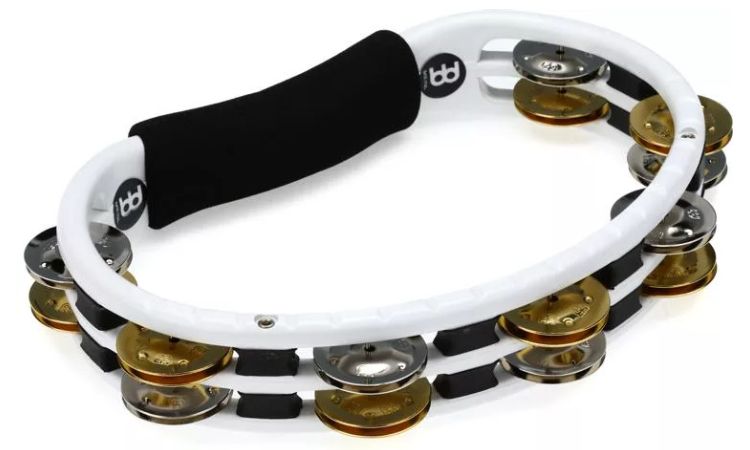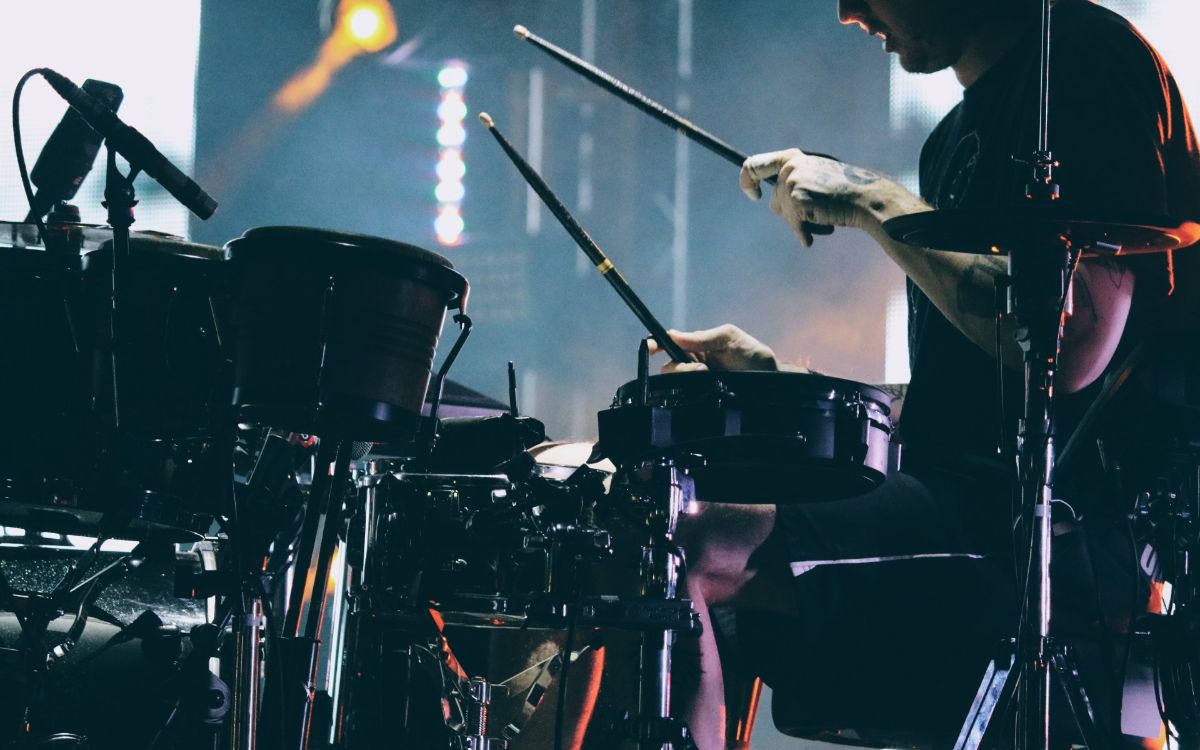If you’re looking to add some dynamic sounds to your drum setup, you should consider using some auxiliary percussion accessories. They will give you different sounds and moods that you can play with to add variety to your overall drum sound.
There are several types of auxiliary percussion instruments that you can use, and each has unique qualities that make it effective in different settings. We’re going to look through a list of potential drum add ons for your kit.
Contents
What is Auxiliary Percussion?
Before we get into all the different examples, I think it’s important to explain what auxiliary percussion is. It’s a fairly broad term that describes any percussion instrument that you can play on the side of your drum set.
If it’s a drum set add-on that you can hit it with a stick to make a sound, or if it has some sort of pedal mechanism, it most likely falls under the category of auxiliary percussion.
A good way of thinking about it is that most auxiliary percussion instruments are played with other parts of the drum set simultaneously. It’s not a dedicated instrument that gets studied like drums or piano.
By blending auxiliary percussion in your grooves and playing, these instruments can add a unique sound effect that can play an important role within the styles of music you play.
Why Drummers Use Auxiliary Percussion
Auxiliary percussion can add depth, texture, and rhythmic accents to compositions. Auxiliary instruments come in various shapes, sizes, and materials, each producing its own unique sound and character.
From shakers and tambourines to sleigh bells and woodblocks, adding other percussion instruments offers drummers and musicians a new sonic palette to explore.
Auxiliary percussion is also able to contribute to the overall atmosphere of a composition. These instruments have unique tonal qualities that can evoke specific moods or create a particular ambiance.
From the tribal percussive sounds of the timbale to the sharp ring of a triangle, auxiliary instruments bring a rich layer of depth.
Auxiliary Percussion Meets Genre-Specific Requirements
The choice to incorporate auxiliary percussion can also be influenced by genre-specific requirements. Different musical styles call for different instruments.
For example, Latin or Afro-Cuban music often features congas, bongos, or timbales, while jazz or funk may incorporate tambourines or shakers.
By incorporating these instruments into their drum set, drummers can authentically capture the essence and energy of specific genres.
10 Percussion Accessories to Add to Your Drum Set
Tambourine

The tambourine is typically one of the first things people think about when discussing percussion instruments. A standard tambourine will have a bunch of jingles that are connected to a metal or plastic frame. You’re supposed to shake it and hit it with your hand to get the intended sounds.
While hand tambourines are cool and all, it’s a bit difficult to shake one while playing the drums at the same time. A common practice for drummers is to place the tambourine on top of the hi-hats. You’ll get the jingle sound every time you hit the hats with a stick. You’ll also get a strong jingle sound when you press your left foot down.
Another great drum set addition would be a foot tambourine. You get a tambourine that is connected to a pedal, allowing you to play it with your foot. You can place it anywhere you’d like, but most drummers place it to the left of the hi-hat pedal.
Cowbell

Cowbells are incredibly popular drum kit add ons, especially in rock and Latin drumming. They range in size and weight. Smaller and lighter cowbells are higher-pitched while larger and heavier ones are lower-pitched.
A great example of a cowbell made for drummers is the Meinl Mike Johnston Groove Bell. It’s a cowbell designed to have adjustable sound qualities, making it a fantastic addition to your drum kit.
Cowbells typically come with a hole and locking wing nut that allows you to attach them to a rod. You’d need to buy a separate mounting rod to attach to your kit. Some drummers like to attach the cowbell to their snare drum while others attach it to the rim of the bass drum.
Woodblock

Sticking with the theme of attaching an instrument to a rod, another great auxiliary percussion add-on would be a wood block. Woodblocks produce sounds that are a bit sharper and shorter than cowbells.
While they’re not as universally used, you can hear many drummers using woodblocks very tastefully in their playing. A great example would be the popular UK jazz drummer, Yussef Dayes. If you listen to his songs, you’ll hear him using a very strong woodblock sound every now and then.
Not all woodblocks are designed for drum sets, so you need to make sure to get one that can connect to a rod like this Native Tongue Percussion RhymBlock.
Wind Chimes

Wind chimes are a group of metal rods that are hanging by strings. They’re typically hung in sequence from smallest to biggest near the hi hat cymbals in a drum set. Another name for them would be a mark tree.
They’re intended to be played with a stick by taking it and dragging it from end to end. You’ll either get a sparkly sound that goes from low pitch to high pitch or vice versa.
The main places where you’ll see drummers using these auxiliary instruments is in theater shows. The sound adds a sense of mystery and excitement, but it’s typically notated in music when the scene needs it.
Out of all the drum set add ons of this list, wind chimes are probably the least versatile as they have a very specific use.
Timbale

Timbales are shallow drums that usually have very high-pitched attacking tones. They’re excellent to add on drums because they’re very similar to rack toms. However, they achieve a strong sound that you’d never be able to replicate with a rack tom.
They typically come in pairs and are attached to a single strand. Some drummers place them just next to the rack toms while others replace their rack toms entirely with the timbales. Whatever you choose to do with them, they’ll be incredibly fun to play on.
A great set of timbales to check out are the LP256s from Latin Percussion. They give you a highly authentic Latin sound to add to your drum setup.
Shaker

It’s never a bad idea to have a shaker lying around. While the tambourine is quite difficult to play while you’re playing drums, a shaker is a lot easier as it just requires an up and down motion with your hand.
If you’re playing a softer gig in an intimate setting, you could hold a shaker with your right hand and use it instead of playing on the hi-hat. You’d get a much subtler sound. While shaking it, you can use your left hand to play all the drums.
There are a few different shaker designs that you can get. However, most people agree that you can never go wrong with a classic egg shaker.
Different egg shakers will have varying levels of intensity depending on what type of material they have inside of them.
Bongos

Bongos are meant to be played with your hands. However, you could set them up on the side of your kit and play them with your drum sticks. They also always come in pairs, similar to timbales. However, bongos will give you a warmer sound. It’s also nice to have the option of playing them with your hands. You can’t do that with timbales.
You’d just need to be careful not to damage the bongos. The skin will also wear out much faster with sticks than it would with hands. Lighter sticks are usually a better idea.
Luckily, you won’t be playing the bongos as often as you would if you were a primary bongo player. So, the skins should last a fairly long time when the bongos are being used as an auxiliary percussion add-on.
Cabasa

A cabasa is a percussion instrument that has a set of beads that are attached to a handle. You’re meant to hold the handle in one hand and rotate the beads with the other. On its own, a cabasa wouldn’t be a good drum set add-on.
However, you can get a foot cabasa that works similarly to a foot tambourine. You just need to place it somewhere where your left foot can play it and you have an extra sound to play around with in your drum kit.
The sound the cabasa makes is quite short and aggressive, making it a great instrument to have when you want a cutting tone.
Side Snare

A side snare has the potential to be one of the most versatile percussion add ons. Since it’s not your main snare, you have more freedom to play around with tones.
A side snare can be any size, but they tend to be smaller than the main snare. Side snares are typically around 12 or 13 inches in diameter.
You can tune your side snare to sound very low and beefy, further boosting that effect with a Big Fat Snare Drum. You could also get weird with electronic sounds by placing a splash cymbal on it or using something like the Sabian Hoop Crasher.
Electronic Drum Pad

Electronic drum pads are arguably the future of drumming. Every drummer playing for a mainstream pop artist nowadays has one of these at the side of their kit. You’ll even see rock and metal drummers using them occasionally.
Drum pads are used to run click tracks, play electronic drum sounds, run samples, and everything in between. If you really want to up your potential with what you can do on the drums, get an electronic drum pad.
The most popular one to include within drum sets would be the Roland SPD-SX.
Wrapping Up
Every drummer should play around with percussion accessories at some point in their drumming journeys. Whether you’re using a simple egg shaker or a complex drum pad, having drum add ons will challenge you and encourage you to explore new musical ideas.
Certain styles of music need auxiliary instruments, especially jazz and Latin. Other styles can greatly benefit from it, like having a cowbell when you’re playing with a classic rock band.
Choose some of these add ons that sound most interesting to you and then see what you can do with them. You’ll have a lot of fun through that process!









